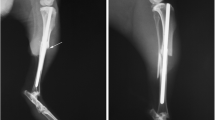Abstract
Prostaglandin E therapy in infants causes periosteal elevation. Although the changes usually take 30–40 days to become visible, we have seen them as early as nine days. In 15 infants who had prostaglandin E therapy for over six days, three developed periosteal elevation. Three other cases are described in greater detail, with long-term follow-up in two in which the bone remodeled to normal. Gallium scan in one showed increased uptake in areas involved. The periosteal cloaking may mimic Caffey disease but the pattern of involvement is different, since the mandible, which is commonly affected in Caffey disease, is rarely involved in prostaglandin E therapy.
Similar content being viewed by others
References
Benz-Bohm G, Emons D, Schickendantz S, Mallmann R, Redel D, Knöpfle G, Mennicken U (1984) Cortical hyperostoses caused by long standing prostaglandin E2 therapy. Radiologe 24:72
Chyun YS, Raisz LG (1984) Stimulation of bone formation by prostaglandin E2. Prostaglandins 27:97
Heyman E, Laver J, Beer S (1982) Prostaglandin synthetase inhibitor in Caffey disease (letter to the editor). J Pediatr 101:314
Makley JT, Dunn MJ (1982) Prostaglandin synthesis by osteoid osteoma (letter to the editor). Lancet 2:42
Martin TJ (1983) Drug and hormone effects on calcium release from bone. Pharmacol Ther 21:209
Nakagawa T, Hamada S, Nishiki T, Yamamoto I, Tachi K, Takahashi H (1983) Prostaglandin-induced periostitis. Rinsho Hoshasen 28:715
Ringel RE, Brenner JI, Haney PJ, Burns JE, Moulton Al, Berman MA (1982) Prostaglandin-induced periostitis: a complication of long-term PGE1 infusion in an infant with congenital heart disease. Radiology 142:657
Ringel RE, Haney PJ, Brenner JI, Mancuso TJ, Roberts GS, Moulton AL, Berman MA (1983) Periosteal changes secondary to prostaglandin administration. J Pediatr 103:251
Sone K, Tashiro M, Fujinaga T, Tomomasa T, Tokuyama K, Kuroume T (1980) Long-term low-dose prostaglandin E1 administration (letter to the editor). J Pediatr 97:866
Teixeira OHP, Carpenter B, MacMurray SB, Vlad P (1984) Long-term prostaglandin E1 therapy in congenital heart defects. J Am Coll Cardiol 3:838
Ueda K, Saito A, Nakano H, Aoshima M, Yokota M, Muraoka R, Iwaya T (1980) Cortical hyperostosis following long-term administration of prostaglandin E1 in infants with cyanotic congenital heart disease. J Pediatr 97:834
Yoneda T, Mundy GR (1979) Prostaglandins are necessary for osteoclast-activating factor production by activated peripheral blood leukocytes. J Exp Med 149:279
Author information
Authors and Affiliations
Rights and permissions
About this article
Cite this article
Poznanski, A.K., Fernbach, S.K. & Berry, T.E. Bone changes from prostaglandin therapy. Skeletal Radiol 14, 20–25 (1985). https://doi.org/10.1007/BF00361189
Issue Date:
DOI: https://doi.org/10.1007/BF00361189




